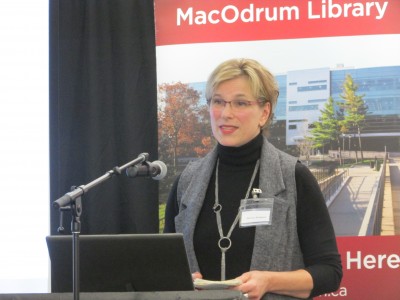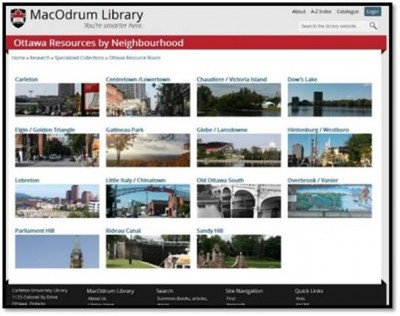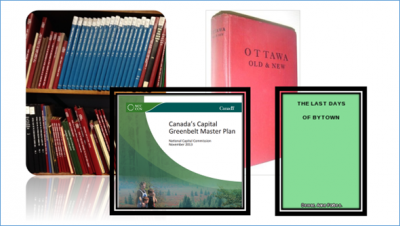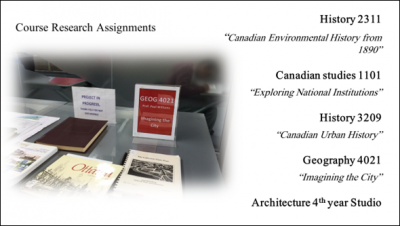MacOdrum Library Officially Opens Ottawa Resource Room: What This Means for Local Historians
For years, historians and heritage professionals in Ottawa have benefited from the resources of the Ottawa Room at the Ottawa Public Library. Now, researchers interested in the National Capital’s history have a new resource centre they can consult: The Ottawa Resource Room at Carleton’s MacOdrum Library. Its collection offers special value to historians and heritage professionals working on the National Capital Region.
The Ottawa Resource Room officially opened on February 4, 2016 to a packed room of faculty and students, architects and archaeologists, federal government employees and members of Ottawa’s local heritage community. A variety of speakers – including University President Dr. Roseann O’Reilly Runte, Ottawa Councilor David Chernushenko, and Canadian Studies Professor Susan Ross – described the new site as a place that fulfills a responsibility to the city, as well as to the research community.
During the launch event, Ottawa Resource Room Coordinator Monica Ferguson spoke about what makes the room different: hands on access to an extensive paper map collection, extensive municipal and federal government information, a variety of collections and exhibits from Carleton’s own archive, and GIS and digital data curated by the Library’s Maps, Data, and Government Information Centre (MADGIC) team.

History M.A. student Christopher Ryan, who researches low-income housing initiatives in the 1950s and 60s in Ottawa, sees a lot of potential: “When you’ve got an extensive (and growing) collection in one place, I think that researchers of all sorts who are interested in Ottawa will be attracted to it. This will definitely give the locally-oriented folks in the history department a place to go, as well as the local history and heritage community.”
About the Ottawa Resource Room
Housed on the Library’s first floor, the Ottawa Resource Room also has a strong presence on the internet. Visitors to the website will note that the collection is curated visually according to neighbourhood—offering visitors a strong cue of the collection’s focus on enabling local stories.
Fifteen community boundaries help organize the collection, including Carleton University itself, LeBreton, Little Italy/Chinatown, and Overbrook/Vanier. While some neighbourhoods in the National Capital Region are absent from this list, their absence does not preclude using the Room to research the lesser known areas of the city. Carleton professor and historian of Ottawa Bruce Elliott urges his students to explore less well-known neighbourhoods for term papers in his urban history course. “Students comparatively new to Ottawa often decide what neighbourhoods to focus on for their term paper by browsing planning studies, or comparing maps and aerial photographs to identify neighbourhoods that are topographically distinctive, or that have changed significantly over time, or simply to get a quick approximate date for when a neighbourhood begins to appear on maps.” This approach has led to original local histories of neighbourhoods such as the Bells Corners mobile home park, explorations of contested open space in Alta Vista, and an unimplemented garden suburb plan for the site of Carleton University (all published as prize-winning essays in the Historical Society of Ottawa’s pamphlet series).

The collection focuses on three urban “zones.” Zone 1 includes the Carleton Campus and its surrounding community. Zone 2 extends to the current boundaries of the city of Ottawa. And finally, Zone 3 encompasses the area covered by the National Capital Commission and the former Federal District Commission, extending into Quebec.
In addition to physical collections, the Ottawa Resource Room offers important pedagogical resources for faculty and students. The site is a laptop compatible study and teaching space that includes a wireless projector and offers ample space for poster displays and presentations. Carleton History Professor Joanna Dean appreciates both the flexibility and the interdisciplinary nature of the space. “Instructors are able to leave a selection of historical maps and other related documents out for a class, and students can consult them through the term. It is always interesting to see what students in other courses, and in other disciplines, are using.”
Select Historical Resources at the Room
Users of the Ottawa Resource Room will find a range of useful materials for conducting original research into the capital’s past. From physical documents to curated links to local heritage sites, this is a great place to begin interdisciplinary research projects.
Historical Topographic Maps of Ottawa
The library offers high resolution, large scaled digital maps of Ottawa (ranging from 1:1,200 to 1:2,500) for the periods 1934-1980. While the physical maps can be consulted on site, the digital copies allow for a close examination of individual neighbourhoods.
These digital maps are complemented by historical ones for the period 1958 to present; digital and physical copies of the Illustrated Historical Atlas of Carleton County, and three onsite copies of Thomas Nagy’s Ottawa in Maps: a Brief Cartographical History of Ottawa, 1825-1973 (1974).
For those who want to take their research beyond the Ottawa Resource Room, the website offers links to a map of Ottawa’s Heritage Conservation Districts, hosted by the City of Ottawa, as well as LAC’s Fire Insurance Plans for the nineteenth century. That said, researchers do not necessarily need to visit external resources to access some of these documents. The Room has an original 1956 Fire Insurance Atlas of Ottawa, and many century-old Fire Insurance Plans for villages such as Carp and Manotick.
“One of the most chilling resources,” says Dean, “is the map produced during the Cold War showing the exit routes from Ottawa in case of nuclear attack.” This Civil Defence artifact is available both physically and digitally.
Primary and Secondary Records
A number of primary and secondary textual resources can be consulted on site. For example, those interested in the early history of the capital might consult books from the Historical Society of Ottawa such as Law and Order in the Early Days of Bytown/Ottawa (1992), or Bytown and the Cholera Epidemic of 1832 (1993), or Jim Burant’s History of Art and Artists in Ottawa and Surroundings, 1790-1970 (1993).

Students and faculty interested in built and intangible cultural heritage will also find useful resources here. Book and reports by local architects, the National Capital Commission, and Heritage Ottawa are readily available, often with multiple copies onsite.
Says Elliott: “I was particularly excited when Wayne Jones said that the Library will be archiving reports from the City of Ottawa website. As the City’s website is mostly oriented to current needs, things like Heritage Conservation District or planning studies tend to have a short electronic shelf-life and quickly disappear from the City website. Given the closing of the NCC Library during the Harper regime and the dearth of digital resources provided by the Ottawa Public Library’s Ottawa Room, it is useful to have both a physical and a virtual space at Carleton with a staff dedicated to curating and expanding resources and access.”
Those whose interests are federal in scope will find resources on-hand and online. Links to the multiple planning reports created by the Federal District Commission in the twentieth century are found alongside links to Historical Statistics of Canada and archived Census reports for the 1800s.
Curated Links
While much web-based research begins and ends with a search engine, the Ottawa Resource Room website offers history and heritage researchers a curated list of links to government sites, local and federal archives, heritage organizations, and popular local heritage blogs. Having a list of relevant and quality sites all in one place positions the resource centre as an invaluable research hub for online research.
Interdisciplinary Research Hub on Ottawa
Elliott observes, “The Ottawa Resource Room represents a drawing together of local resources on campus, and a first point of contact for expanding student research beyond our own holdings to those of the numerous other repositories in the area.” His hope is “that the Ottawa Resource Room will become a stimulus for new projects creating and linking additional resources. It should also become a space where faculty and students in different courses and disciplines can meet to interact and benefit from one another’s work.”

This interdisciplinary aspiration is at the centre of the Ottawa Resource Room. While historians may wish to start with the curated list of historical documents and links, they might also browse other topics. Place-based browsing can help connect the past with the present and guide research questions that are both historically significant and relevant to people living in these neighbourhoods today.
Alternatively, consulting sections on urban planning, or buildings could help illustrate the changing tools and paradigms deployed by professional architects and planners over time. Ross, whose students have used the Ottawa Resource for many months now, found that “studying urban renewal reports of the 1960s revealed that a zone north of [Macdonald Gardens] was identified as one of the city’s first heritage conservation areas. These findings helped us to define the layered character of a much-changed district in ways that help connect contemporary social values with community heritage.”
To find out more about the Ottawa Resource Room launch event, see a recently published article by Carleton’s Department of University Communications.
Post by Shawn Anctil, with special thanks to Joanna Dean, Bruce Elliott, Monica Ferguson, Patti Harper, Sylvie Lafortune, Susan Ross and Christopher Ryan for their contributions.